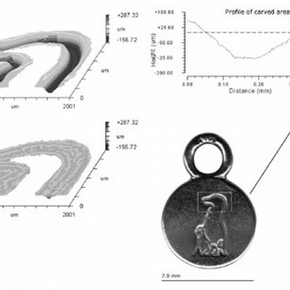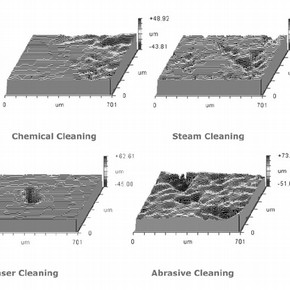Conservation Journal
Autumn 2000 Issue 36
Topographical Studies in the Conservation of Statuary Materials
Pedro Gaspar, RCA/V&A Conservation, Cleaning Inorganic Materials, PhD student, Alan Cummings, Pro-Rector, Royal College of Art, David McPhail, Senior Lecturer, Imperial College, Charlotte Hubbard, Senior Sculpture Conservator
Introduction
Surface texture is a key parameter in statuary materials, where its study and preservation is central to conservation research. The characteristics of white light interferometry make this technique a potential resource for topographical studies in this field. This article assesses the potential applications of the ZYGO - Newview 100 3D Imaging Surface Analyser 1 for conservation studies. The importance of surface texture in sculpture is presented, as well as the fundamentals of this analytical technique, demonstrating its suitability for topographical studies. A methodology is proposed, based on several parameters derived from the statistical models that characterise surface topography and, in addition, two examples are presented, focusing on the characterisation of statuary materials, and on the assessment of surface treatments used in conservation.
Topography in surface studies for conservation
The concept of surface is always present when dealing with artworks. It is often regarded as the most important and representative part of an object, due mainly to the defining of an external boundary through which a response to the artwork's characteristics is achieved and an aesthetic interaction is established. Associated with an object's surface are properties that describe its characteristics and that are central to its interpretation. Texture is one of these properties and its importance in sculpture is fundamental. Surface texture, either as an expression of smoothness (clearly present in Neo-classical sculpture) or in the form of rougher surface finishes (e.g. surfaces textured with fine marks of chiselling, in ancient Greek statuary) relates directly to the perception of an object, this being as a tactile or optical experience. Texture is a concept that naturally follows the notion of form that defines sculpted objects. The appreciation of this form is first acquired by the perception of a surface and the response to its texture.
One of the focuses of conservation is the study and preservation of an object's intrinsic properties. One aspect of these activities is the preservation of, and respect for the original surface. As regards form and texture, while a qualitative appreciation of these is essential, conservators should ideally be able to quantify these parameters. This introduces the concept of topography as a measurable parameter for surface studies, and imposes the need to obtain accurate surface topography measurements, which will be central to the methodology for analysing, monitoring and assessing surface modifications.
Surface topography measurements
Measurements of surface topography provide information on surface characteristics that are quantified in terms of the ordinate height of surface asperities (peaks and troughs). There are several techniques available for surface topography measurements:
-
Traditional mechanical stylus profilometry techniques
These have several disadvantages that make them inappropriate for use in conservation. The movement of a stylus in contact with a surface may induce distortion or damage on surfaces, thus limiting the appropriateness of this technique on artworks. Also, the anisotropic nature of these surfaces reveals important historical and technical information. The use of a 2-D analysis presents a fundamental limitation for assessing these 3-D surfaces.
-
White light interferometry
A non-contact analysis based on 3-D measurements, represents a more realistic approach to surface analysis in conservation. To overcome the limitations of mechanical topographical measurements in conservation, non-contact optical methods may be used to generate 3-D topographical maps. White light interferometry provides measurements by recording interference patterns formed by light reflected from the sample surface and a reference surface. The optical interference between the two reflected beams is related to the surface height (z and is given as a function of light intensities.
The ZYGO - Newview 100 3D Imaging Surface Analyzer is an instrument in which topographical measurements are made by means of scanning white light interferometry. Its characteristics make it a valuable tool for topographical analysis in surface studies within conservation. Amongst the more important features are the fact that 3D image data are produced and that is a non-contact technique with high vertical resolution (1nm). The software allows several images to be stitched together so that large areas may be assessed (several mm2).
Parameters for the characterisation of surfaces
The surface topography may be evaluated with a 3D digital height record, using statistical models that assess the distribution of surface heights. From these models, practical statistical, scale-dependent parameters are derived that will be used to characterise surface properties. Any methodology for surface topography analysis in this case is based on topographical maps, illustrating the distribution of surface heights, supported by quantifying parameters. These are defined according to the properties intended for analysis.
The parameters most relevant for conservation studies are presented as follows:
a) Amplitude parameters
i) Root mean square deviation of the surface Sq- Dispersion parameter defined as the root mean square value of the surface heights. This gives a representation of the mean values of surface heights, illustrating the average surface texture of the surface.
ii) Ten point height of the surface Sz- Extreme parameter defined as the average of the absolute heights of the five highest peaks and the depths of the five deepest valleys. This is a parameter that illustrates pronounced topographical features.
iii) Skewness of topography height distribution Ssk - Measure of asymmetry of surface deviations about the mean plane. This parameter is used to describe the shape of the topographic height distribution. For a symmetric shape of surface height distribution, Ssk=0.
b) Spatial parameters
i) Texture aspect ratio of the surface Str- This parameter is used to describe texture patterns (S 0.5 for strong uniform texture while Str < 0.3 defines strong long crestness).
ii) Texture direction of the surface Std - This parameter determines the pronounced direction of the surface texture:
c) Area and Volume parameters
i) Material volume ratio of the surfaces (Smr)- This parameter is defined as the material portion enclosed in a plane parallel to the mean plane and the interfacial surface. This can be complemented with the Void volume ratio of the surface (Svr), representing the air volume enclosed between a truncation plane at a given level parallel to the mean plane and the material beneath the plane. Both parameters are used to understand the dimensions of valleys and pores on surfaces.
d) Functional parameters
These parameters characterise the functional properties of surfaces. A relevant example is the surface fluid retention ability. The analysis of this parameter illustrates the potential of the surface to retain fluid and the zones most likely to be affected by it.
Case Study One: monitoring of objects' surfaces
The study of museum objects is one of the potential applications for light interferometry, which provides a means of monitoring gradual changes in surface topography or detect abrupt modifications as a result of conservation treatments. The ability to measure areas of pre-defined dimensions and location also makes it possible to characterise features on objects' surfaces, contributing to our technical knowledge surface finishing techniques.
This example focuses on the analysis of the carved area of the object shown in Figure 2, establishing an initial characterisation of the detailed region. The separation between waviness and roughness allows topographical measurements in the long and short-wavelengthregions. The former provides information on form, with a clear indication of the dimensions of the carved area, carving technique and type of tools used, while the latter focuses on the surface roughness, and can be used to reveal further information on fine texture and on finishing techniques.
The monitoring of surfaces can be achieved by comparison between topographical maps of the same area, and/ or using roughness values as quantifying parameters (for the profile shown in Figure 2, Sq=73.8um). The detection of localised alterations can help to prevent further damage. The recognition of different types and degrees of surface modifications can be used to predict and understand the object's deterioration mechanisms and to analyse the impact of the surrounding media and display conditions on museum objects.
Case Study Two: Assessment of surface treatments
The assessment of the effects of interventive treatments on statuary materials' surface topography is another potential application of white light interferometry. The nature of this technique makes it suitable for the identification and analysis of modifications induced on surfaces by cleaning treatments used in sculpture conservation.
Laser cleaning, abrasive cleaning, chemical cleaning and steam cleaning are methods used in conservation for the cleaning of statuary. The fundamentals of these methods differ in nature and the interaction with surfaces will vary with the treatment used. This is illustrated in Figure 3 and shows deliberate damage on statuary materials after cleaning treatments and illustrates potential areas for research focus. The comparison of treated and untreated areas provides information about the interaction of different cleaning techniques with solid surfaces.
Cleaning techniques induce alterations in surface topography and different patterns of surface damage are evident in different situations. These surface maps and the parameters associated with the quantification of topographical information are used to predict the behaviour of surfaces under treatment and help to prevent any damage. At the resolution achievable, alterations may be detected at the sub-micron level. Surface monitoring can therefore provide a degree of control in the repetitive use of cleaning treatments. Surface alterations will occur but the technique will assist the conservators to avoid visible and irreversible damage. The question of the extent to which surface modification is acceptable, must of course be addressed.
The use of white light interferometry for the study of cleaning methods and their impact on surface topography will help to establish threshold values, defining acceptable and quantifiable degrees of surface alteration. Our understanding of the mechanisms involved in surface treatments will be enhanced. The relative suitability of different conservation treatments for different purposes will be established and a greater degree of control during treatments will be possible.
Much of the monitoring of surfaces in conservation practice currently relies on visual inspection. A study based on the assessment of surface topography, as proposed, will lead to improved methods of treatments in sculpture conservation and extend our knowledge of the materials and techniques involved.
References
Bibliography
Hall,. J., The world as sculpture - the changing status of sculpture from the renaissance to the present day, Chatto & Windus, London, 1999.
Brundle, C., Evans Jr, C., Wilson, S. (ed) Encyclopaedia of materials characterisation - surfaces, interfaces and thin films, Butterworth - Heinemann, 1992.
Stout, K., Sullivan, P., Dong, W., Matsusah, E., Luo, N., Mathia, T., Zahouani, H.. The development of methods for the characterisation of roughness in three dimensions. Published on behalf of the commission of the European Communities, UK, 1993.
The author is contactable on:
Acknowledgements
Pedro Gaspar is funded by 'Fundação para a Ciência e para a Tecnologia', Portugal.
Autumn 2000 Issue 36
- Editorial - Science Meets Art in South Kensington
- Conservation Award
- Creating Sparks
- Defining Conservation Science: Training and the Profession
- Postgraduate Training in Conservation at the Hungarian National Museum
- Science and Art: Separated by a Common Language?
- Science in the Galleries
- Topographical Studies in the Conservation of Statuary Materials
- Printer Friendly Version


